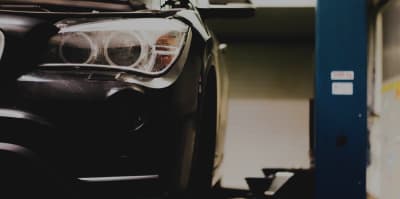
The Diesel Particulate Filter on your car will look quite a lot like an muffler, but you will find it mounted much closer to the engine where it is warmer. The heat from the engine helps the DPF heat up faster and subsequently burn off the soot particles much more quickly. If the DPF warning lights comes on then you should attempt to use a cleaner to clear any blockages first as this is a much cheaper and less intrusive way of fixing the problem.*
If this does not work then you can consider replacing the DPF and installing a new one. If you want to keep the cost of replacement down then you can purchase a new Diesel Particulate Filter online or at a garage and install it yourself at home to save on fitting costs. This is a step by step guide on how to replace your DPF should you need to.
Step 1 – Jack up your car
Park on a clear, flat surface and use jacks to raise all four wheels off the ground. The DPF is located well under the car so you will not be able to reach it from the side of the vehicle, you will need to lie right under the middle of the car in order to gain full access. You will be spending a considerable amount of time under the car so make sure that it is secure.
Step 2 – Locate the DPF
DPFs vary slightly in size, shape and colour but will generally consist of a widened section of exhaust tube and will be located close to the engine, underneath the car.
Step 3 – Remove bolts and screws
Take a minute to study the exact positioning of the DPF so that you know precisely where to fit the new one. Taking photos of the DPF in position can be helpful as they will serve as a good point of reference if you get stuck later on. Remove all of the screws and bolts which are holding the DPF in place and keep them safe to one side, you will need them to install the new filter. You won’t need to remove the filter from its heat guards as the new filter should come with heat shields of its own. This makes it easier to remove as you should be able to simply take it off in one piece.
Step 4 – Attach the new filter
Take a minute to consult the photos you took of the old DPF in position so that you are familiar with the correct orientation for the filter and where all of the bolts and screws should go. Fit the new DPF in exactly the same position as the old one, taking care to replace all of the nuts and screws and any washers which came off the original filter.
Step 5 – Check that it’s secure
Test with your hands to make sure that you have tightened the DPF in place and that there will be no leaks in the exhaust system. Even a slightly loose fitting between different sections of pipe can cause big problems such as lack of pressure and increased fuel consumption. It is really important to make sure that all of the fittings are as tight as you can make them.
Step 6 – Lower the car
Don’t forget to clear the area underneath the car of any tools which you may have used in the removal and replacement of your DPF. Then lower the jacks one by one so that the car is resting on the floor once again.
Step 7 – Test your handiwork
Drive your car for 15 minutes or so, preferably on quiet, open roads where you can build up some speed, and wait for the DPF warning light to go off. If any other warning lights come on, or if you notice anything wrong with the car at all, stop the engine and take the car into a garage or workshop as soon as possible to find out what the problem is. It could be that you dislodged something accidently whilst working on the car. If the DPF warning light goes off and there are no other problems with the way the car is driving then you can consider the replacement to have been a success.
Step 8 – Maintenance
Remember to use DPF cleaner on a regular basis to make sure that this new filter lasts much longer and works more efficiently than the last one. Otherwise you could find yourself repeating the whole process much sooner than you had hoped.
All about Exhaust
- How to Diagnose Problems with Your Exhaust
- How to Repair a Split Exhaust
- How to Protect Your Exhaust from Rust
- How to Remove the Rust from Your Exhaust Pipe
- What is the Catalytic Converter?
- How to Replace the Catalytic Converter
- What is a Diesel Particulate Filter?
- How to Replace the Diesel Particulate Filter (DPF Replacement)
- What is a Diesel Particulate Filter Cleaner? How To Use It.
- Why is the Particulate Filter Required by Law?
- What is DPF Regeneration?






